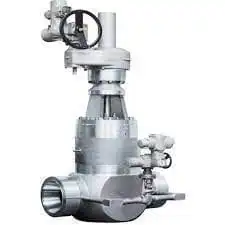 The characteristics of structure of power station gate valves are as follows:
The characteristics of structure of power station gate valves are as follows:3. The structure of wedge type elastic single plates and wedge-type double plates can avoid the deformation of the valve body due to temperature changes, resulting in jamming of valve plates. The elastic compensation effect of elastic grooves and free swing of double plates can compensate the sealing leakage caused by the deformation of the valve seat body, and the sealing performance is reliable.
4. The sealing surface of the valve plate and seat is welded with cobalt based hard alloy, which is wear-resistant, high-temperature resistant, corrosion-resistant, scratch-resistant and has a long service life.
5. The valve cavity adopts a pressure self-tightening seal. Under the action of the medium pressure, the valve bonnet moves upward to form a seal at the conical sealing ring. The higher the medium pressure is, the greater the sealing force becomes; sealing is reliable.
6. The valve stem is treated with anti-corrosion nitriding, and the surface hardness of the valve stem is as high as 800 to 1200HV, which makes the valve have good corrosion resistance and scratch resistance.
7. Top mounted stem nuts: The valve nut is equipped with a thrust bearing to reduce the valve opening and closing torque, and it is flexible and easy to open and close the valve.
